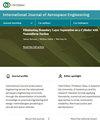GPS-SBAS-Based Orbit Determination for Low Earth Orbiting Satellites
IF 1.2
4区 工程技术
Q3 ENGINEERING, AEROSPACE
引用次数: 0
Abstract
A space-based augmentation system (SBAS) provides real-time GNSS correction signals via geostationary satellites for near-ground GNSS users. To use the SBAS correction for low Earth orbit (LEO) satellites, the correction, especially the ionosphere correction, must be adjusted for the LEO altitude. We apply modified SBAS data to LEO satellite onboard navigator to improve the positioning accuracy of a LEO satellite for possible real-time use. The onboard navigator requires high positioning reliability, and code pseudoranges, rather than phase pseudoranges, are used for the primary measurements. The Galileo NeQuick G model is used to determine the real-time conversion factor of the SBAS ionosphere correction for a LEO satellite. The GPS L1 data from GRACE satellite are combined with the SBAS data from the ground receiver. The onboard navigator combines the precise satellite dynamic model with an extended Kalman filter to improve positioning accuracy and stability. The kinematic positioning method, which uses the weighted least square method without the dynamic model, is also performed for comparison. The SBAS correction reduces the positioning error in both the kinematic positioning and the dynamic positioning. The positioning error reduction of the GPS and WAAS case over the GPS-only case is 25.2% for the kinematic method and 30.6% for the dynamic method. In the case of the dynamic method with the SBAS corrections, the positioning error remains smaller than that of the GPS-only dynamic method even after the satellite has left the SBAS service area.基于gps - sbas的低地球轨道卫星定轨
天基增强系统(SBAS)通过地球静止卫星为近地GNSS用户提供实时GNSS校正信号。为了对近地轨道(LEO)卫星进行SBAS校正,必须根据近地轨道高度对其校正,特别是电离层校正进行调整。我们将修正后的SBAS数据应用于LEO卫星机载导航仪,以提高LEO卫星的定位精度,实现实时使用。机载导航仪对定位可靠性要求高,主要测量采用码伪距,而不是相位伪距。利用Galileo NeQuick G模型确定了低轨道卫星SBAS电离层校正的实时转换系数。GRACE卫星的GPS L1数据与地面接收机的SBAS数据相结合。机载导航仪将精确的卫星动态模型与扩展的卡尔曼滤波相结合,提高了定位精度和稳定性。采用不考虑动态模型的加权最小二乘法进行运动学定位。SBAS修正减小了运动定位和动态定位的定位误差。相对于仅使用GPS的情况,GPS和WAAS两种方法的定位误差分别减少了25.2%和30.6%。在经过SBAS校正的动态方法中,即使在卫星离开SBAS服务区域后,其定位误差仍然小于仅采用gps动态方法的定位误差。
本文章由计算机程序翻译,如有差异,请以英文原文为准。
求助全文
约1分钟内获得全文
求助全文
来源期刊

International Journal of Aerospace Engineering
ENGINEERING, AEROSPACE-
CiteScore
2.70
自引率
7.10%
发文量
195
审稿时长
22 weeks
期刊介绍:
International Journal of Aerospace Engineering aims to serve the international aerospace engineering community through dissemination of scientific knowledge on practical engineering and design methodologies pertaining to aircraft and space vehicles.
Original unpublished manuscripts are solicited on all areas of aerospace engineering including but not limited to:
-Mechanics of materials and structures-
Aerodynamics and fluid mechanics-
Dynamics and control-
Aeroacoustics-
Aeroelasticity-
Propulsion and combustion-
Avionics and systems-
Flight simulation and mechanics-
Unmanned air vehicles (UAVs).
Review articles on any of the above topics are also welcome.
 求助内容:
求助内容: 应助结果提醒方式:
应助结果提醒方式:


